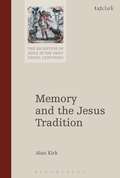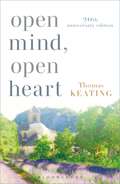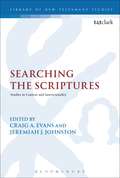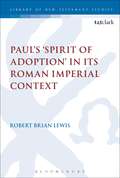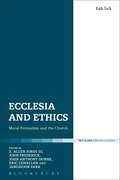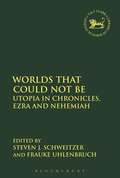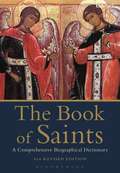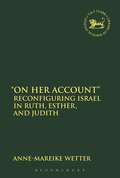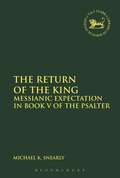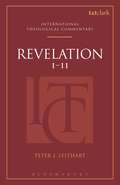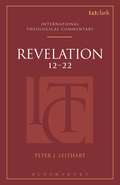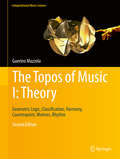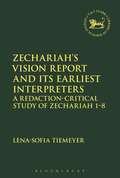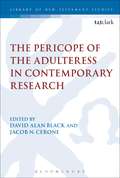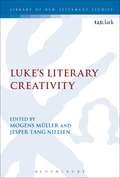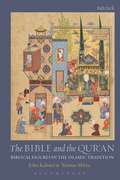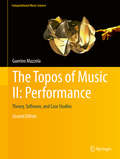- Table View
- List View
Introducing the Women's Hebrew Bible: Feminism, Gender Justice, and the Study of the Old Testament
by Susanne ScholzIntroducing the Women's Hebrew Bible is an up-to-date feminist introduction to the historical, socio-political, and academic developments of feminist biblical scholarship. In the second edition of this popular text Susanne Scholz offers new insights into the diverse field of feminist studies on the Hebrew Bible. Scholz provides a new introductory survey of the history of feminism more broadly, giving context to its rise in biblical studies, before looking at the history and issues as they relate specifically to feminist readings and readers of the Hebrew Bible. Scholz then presents the life and work of several influential feminist scholars of the Bible, outlining their career paths and the characteristics of their work. The volume also outlines how to relate the Bible to sexual violence and feminist postcolonial demands. Two new chapters further delineate recent developments in feminist biblical studies. One chapter addresses the relationship between feminist exegesis and queer theory as well as masculinity studies. Another chapter problematizes the gender discourse as it has emerged in the Christian Right's approaches to the Old Testament.
Informational Environments: Effects of Use, Effective Designs
by Jürgen Buder Friedrich W. HesseThis book provides a multidisciplinary view into how individuals and groups interact with the information environments that surround them. The book discusses how informational environments shape our daily lives, and how digital technologies can improve the ways in which people make use of informational environments. It presents the research and outcomes of a seven-year multidisciplinary research initiative, the Leibniz-WissenschaftsCampus Tübingen Informational Environments, jointly conducted by the Leibniz-Institut für Wissensmedien (IWM) and the Eberhard Karls Universität Tübingen. Book chapters from leading international experts in psychology, education, computer science, sociology, and medicine provide a multi-layered and multidisciplinary view on how the interplay between individuals and their informational environments unfolds. Featured topics include: Managing obesity prevention using digital media. Using digital media to assess and promote school teacher competence. Informational environments and their effect on college student dropout. Web-Platforms for game-based learning of orthography and numeracy. How to design adaptive information environments to support self-regulated learning with multimedia. Informational Environments will be of interest to advanced undergraduate students, postgraduate students, researchers and practitioners in various fields of educational psychology, social psychology, education, computer science, communication science, sociology, and medicine.
Memory and the Jesus Tradition (The Reception of Jesus in the First Three Centuries)
by Alan KirkAlan Kirk argues that memory theory, in its social, cultural, and cognitive dimensions, is able to provide a comprehensive account of the origins and history of the Jesus tradition, one capable of displacing the moribund form-critical model. He shows that memory research gives new leverage on a range of classic problems in gospels, historical Jesus, and Christian origins scholarship. This volume brings together 12 essays published between 2001 and 2016, newly revised for this edition and organized under the rubrics of: 'Memory and the Formation of the Jesus Tradition'; 'Memory and Manuscript'; 'Memory and Historical Jesus Research'; and 'Memory in 2nd Century Gospel Writing'. The introductory essay, written for this volume, argues that the old form critical model, in marginalizing memory, abandoned the one factor actually capable of accounting for the origins of the gospel tradition, its manifestation in oral and written media, and its historical trajectory.
Open-Mindedness in the Bible and Beyond: A Volume of Studies in Honour of Bob Becking (The Library of Hebrew Bible/Old Testament Studies #616)
by Marjo Korpel Lester L. GrabbeThe contributions to this volume reflect upon changing paradigms within biblical scholarship, and in how biblical scholarship is taught. Taken together, they offer a multifaceted and informative indication of how open-mindedness in one's approach can yield fascinating results across the study of the Old Testament/Hebrew Bible.The range in topic of the contributions is exemplified in the difference between the first chapter, which works from the personal anecdote of the changing opinion of its author to make a wider point about models for Pentateuchal formation, and the third chapter, which comments on the current state of the study of ancient Israel in universities today. Other contributions include; an essay on the subject of space as a social construct in Isaiah 24-27; civil courage and whether the Bible allows room for protest; the question of monotheism in Persian Judah; the historical Ezra, and the telling of the story of Joseph (Genesis 50: 15-21) in children's Bibles in the Netherlands. The contributors include Hugh Williamson, Ehud Ben Zvi, Rainer Albertz, Karel von der Toorn, and Christoph Uehlinger.
Searching the Scriptures: Studies in Context and Intertextuality (The Library of New Testament Studies #543)
by Craig A. Evans Jeremiah J. JohnstonThis work critically engages the hermeneutical methods used to analyse the New Testament writings, so that the lenses through which studies of the texts have been traditionally viewed can be revised. Jeremy Hultin contributes an article on the rhetorical use of the chosen citations by Jewish rabbis in their commentary on scripture, while Mark Gignilliat writes on the potential implications for viewing Old Testament Scripture in the manner of the early Church exegetes and theologians. With these two contributions providing a frame for the other chapters, the essays explore a range of topics including the significance of the number 42 in Matthew; the study of Wisdom in Matthew, the extent to which the four gospels are underlined by Hebrew material, if any; the use of Hebrew material in shaping New Testament writings; and the uses of Scripture in the letters of Paul and the letters to the Hebrews.Read separately, these articles provide fascinating insights and revisions to established ideas on intertextuality between the Old/Hebrew Bible and the New Testament writings. Taken together, the collection presents a solid argument for the fundamental revision of our current hermeneutical practice in Biblical Studies.
The Ritualized Revelation of the Messianic Age: Washings and Meals in Galatians and 1 Corinthians (The Library of New Testament Studies #544)
by Stephen Richard TurleyTurley begins by surveying the history of the interface between ritual studies and Pauline scholarship, identifying the scholarly gaps in both method and conclusions and a ritual theory adequate to address such gaps. The focus of the work is then on the two rituals that identified the Pauline communities: ritual washings and ritual meals. Turley explores Galatians and 1 Corinthians, two letters that present the richest spread of evidence pertinent to ritual theory. By exploring Paul's reference to ritual washings and meals with a heuristic use of ritual theory, Turley concludes that rituals in early Christianity were inherently revelatory, in that they revealed the dawning of the messianic age through the bodies of the ritual participants. This bodily revelation established both a distinctly Christian ethic and a distinctly Christian social space by which such an ethical identity might be identified and sustained.
Paul's 'Spirit of Adoption' in its Roman Imperial Context (The Library of New Testament Studies #545)
by Robert Brian LewisRobert Lewis examines Paul's use of the phrase “Spirit of Adoption” in Romans 8:12-17 against the background of its Roman Imperial context in order to shed light on interpretation of Paul's Letter to the Romans. Whereas other scholars have explored what Paul may have meant when he uses the term “adoption” Lewis instead explores the reasons behind Paul's coupling of it with the term “spirit”. Having examined theories for a possible Jewish antecedent for Paul's use of this phrase, and found them less than persuasive, Lewis unlocks the data within the term's Roman Imperial context that significantly clarifies what Paul means when he uses the phrase “Spirit of adoption". Lewis shows that when Paul wrote his letter to the Romans, adoption had become a feature of Imperial succession. Roman religion gave a great deal of prominence to the Roman family spirit - the genius. The Emperor's genius became identified as a deity in Roman religion and its veneration was widespread in Rome as well as the provinces. When Romans 8.12-17 is read against this background, a very different kind of exegetical picture emerges.
Monotheism and Yahweh's Appropriation of Baal (The Library of Hebrew Bible/Old Testament Studies #617)
by James S. AndersonBiblical scholarship today is divided between two mutually exclusive concepts of the emergence of monotheism: an early-monotheistic Yahwism paradigm and a native-pantheon paradigm. This study identifies five main stages on Israel's journey towards monotheism. Rather than deciding whether Yahweh was originally a god of the Baal-type or of the El-type, this work shuns origins and focuses instead on the first period for which there are abundant sources, the Omride era. Non-biblical sources depict a significantly different situation from the Baalism the Elijah cycle ascribes to King Achab. The novelty of the present study is to take this paradox seriously and identify the Omride dynasty as the first stage in the rise of Yahweh as the main god of Israel. Why Jerusalem later painted the Omrides as anti-Yahweh idolaters is then explained as the need to distance itself from the near-by sanctuary of Bethel by assuming the Omride heritage without admitting its northern Israelite origins. The contribution of the Priestly document and of Deutero-Isaiah during the Persian era comprise the next phase, before the strict Yahwism achieved in Daniel 7 completes the emergence of biblical Yahwism as a truly monotheistic religion.
Ecclesia and Ethics: Moral Formation and the Church
by Edward Allen III John Frederick John Anthony Dunne Eric Lewellen Janghoon ParkEcclesia and Ethics considers the subject of Ecclesial Ethics within its theological, theoretical and exegetical contexts. Part one presents the biblical-theological foundations of an ecclesial ethic – examining issues such as creation, and Paul's theology of the Cross. Part two moves on to examine issues of character formation and community. Finally, part three presents a range of exegetical applications, which examine scripture and ethics in praxis. These essays look at hot-button issues such as the 'virtual self' in the digital age, economics, and attitudes to war. The collection includes luminaries such as N.T. Wright, Michael J. Gorman, Stanley Hauerwas and Dennis Hollinger, as well as giving space to new theological and exegetical voices. As such Ecclesia and Ethics provides a challenging and contemporary examination of modern ethical debates in the light of up-to-date theology and exegesis.
Worlds that Could Not Be: Utopia in Chronicles, Ezra and Nehemiah (The Library of Hebrew Bible/Old Testament Studies #620)
by Frauke Uhlenbruch Steven J. SchweitzerThe idea of Utopia was first made current and popular by Sir Thomas More with the publication of his book by the same name in 1516. The 'no-place' that was created has had a fantastic reception history, which makes its application to the biblical books of Nehemiah, Ezra and Chronicles as vibrant as the current scholarship which is ongoing into the Renaissance term and its implications. The essays in this collection take different approaches to the question: are there proto-utopian elements in the three books from the Hebrew Bible? Methodological considerations are to be found, but each essay also moves beyond the methodological constraint to raise the hypothetical question of 'what if?' in different ways.The essays evaluate the potential, and pitfalls, of reading Biblical books as (proto-)utopian. Topics include how utopia construct intricate counter-realities, and how to tell whether a proposal diagnosed as 'utopian' from a modern point of view is meant to motivate its audience to political action. Case studies which read aspects of Chronicles, Ezra and Nehemiah as potential utopian traits include the restoration project of Ezra-Nehemiah and the rejection of foreign wives, utopian concerns in Chronicles, as well as the empire's role in writing a putative utopia, and King Solomon as a utopian fantasy-king.
The Book of Saints: A Comprehensive Biographical Dictionary
by Basil WatkinsNow fully revised and updated The Book of Saints is a comprehensive biographical dictionary of saints canonised by the Roman Catholic Church. It contains the names of over 10,000 saints, including all modern ones, with significant information about their lives and achievements. Each section begins with an illustration of a particular saint, and the volume includes a list of national martyrs, a bibliography, and a helpful glossary.Produced by the Benedictine monks of St. Augustine's Abbey, Chilworth (formerly Ramsgate) this classic resource is now in its 8th edition, and is fully revised to include all the saints canonised in the last ten years, including Pope St John Paul II and Blessed Paul VI.
"On Her Account": Reconfiguring Israel in Ruth, Esther, and Judith (The Library of Hebrew Bible/Old Testament Studies #623)
by Anne-Mareike WetterAnne-Mareike Wetter investigates how the books of Ruth, Esther and Judith contribute to the discussion about Israel's ethnic and religious identity in the formative period following the Babylonian Exile. Although each of these narratives deals with variations of the theme of survival in a hostile world, the question underlying them is a different one: “Who are we, and who is our 'other'?” The narratives are presented as sequels to Israel's history as put forward in other (now biblical) texts, and presuppose God's continuing involvement with his people. However, they subtly modify the way in which Israel can or should relate to her God by suggesting alternatives for official Temple worship or bypassing the latter altogether. While older prophetic texts make use of metaphoric language portraying Israel as YHWH's unfaithful wife, grieving widow, or ravaged virgin, Ruth, Esther and Judith can be construed as embodiments of Israel of a different kind. Wetter argues for a revisioning of Israel in and through the bodies of the three female characters, as a community which is simultaneously vulnerable and inviolable, marginalized and empowered. Their tricksterism, in all its comicality, underlines the precarious situation in which the women and the community they represent are caught. Yet it also has the power to both defeat threats from outside and amend Israel's self-perception on the inside. Israel no longer has to perceive of itself as a battered wife but as one who can deploy her qualities – seductive and otherwise – for the survival of the community.
The Return of the King: Messianic Expectation in Book V of the Psalter (The Library of Hebrew Bible/Old Testament Studies)
by Michael K. SnearlyThe clear structure of psalm groups in Psalms 107-150 can be interpreted as signaling a renewed hope in the royal/Davidic promises. Each psalm group of Book V is organized around a theme or key word that is related to the royal/Davidic hope in the earlier sections of the Psalter: Psalms 107-118; Psalm 119; Psalms 120-137; Psalms 138-145; Psalms 146-150. These words and themes figure prominently at the major seam psalms of the Psalter – Psalms 1-2 and 89. Thus, the content and subject matter at the end of the Psalter is integrally related to the content and subject matter at the beginning. The editorial-critical method used by Snearly is an extension of the method used by David M. Howard, Jr. in The Structure of Psalms 93-100. Snearly also draws from recent insights in the fields of poetics and text-linguistics in order to establish a linguistically based foundation for reading the Psalter as a unified text. The methodology emphasizes parallel features, with special focus on key-word links. This method advances editorial criticism by not only discerning links within a group but also showing that those links do not occur with the same frequency outside of the group.
Revelation 1-11 (T&T Clark International Theological Commentary)
by Peter J. LeithartThe Book of Revelation is the last book in the canon of the New Testament, and its only apocalyptic document, though there are short apocalyptic passages in various places in the gospels and the epistles. This first of two volumes on Revelation offers systematic and thorough interpretation of the book of Revelation. Revelation brings together the worlds of heaven, earth and hell in a final confrontation between the forces of good and evil. Its characters and images are both real and symbolic, spiritual and material, and it is frequently difficult to know the difference between them. Revelation's cryptic nature has ensured that it would always be a source of controversy. This commentary focuses on the theological content, gleaning the best from both the classical and modern commentary traditions and showing the doctrinal development of Scriptural truths. Scholarship on the book of Revelation has nonetheless not only endured, but even captured the imagination of generations of Bible students, both professionals and laypeople alike. Through its focus on the message of the book through scholarly analysis, this International Theological Commentary reconnects to the ecclesial tradition of biblical commentary as an effort in ressourcement, though not slavish repetition.
Revelation 12-22 (T&T Clark International Theological Commentary)
by Peter J. LeithartThe Book of Revelation is the last book in the canon of the New Testament, and its only apocalyptic document, though there are short apocalyptic passages in various places in the gospels and the epistles. This second of two volumes on Revelation offers a systematic and thorough interpretation of the latter chapters of the book. Revelation brings together the worlds of heaven, earth and hell in a final confrontation between the forces of good and evil. Its characters and images are both real and symbolic, spiritual and material, and it is frequently difficult to know the difference between them,Revelation's cryptic nature has ensure that it would always be a source of controversy. This commentary focuses on the theological content, gleaning the best from both the classical and modern commentary traditions and showing the doctrinal development of Scriptural truths. Scholarship on the book of Revelation has nonetheless not only endured, but even captured the imagination of generations of Bible students, both professionals and laypeople alike. Through its focus on the message of the book through scholarly analysis, this ITC reconnects to the ecclesial tradition of biblical commentary as an effort in ressourcement, though not slavish repetition.
The Topos of Music I: Geometric Logic, Classification, Harmony, Counterpoint, Motives, Rhythm (Computational Music Science)
by Guerino MazzolaThis is the first volume of the second edition of the now classic book “The Topos of Music”. The author explains the theory's conceptual framework of denotators and forms, the classification of local and global musical objects, the mathematical models of harmony and counterpoint, and topologies for rhythm and motives.
Jesus and the Scriptures: Problems, Passages and Patterns (The Library of Historical Jesus Studies)
by Tobias HägerlandThe four Gospels unanimously present Jesus as someone who quoted from, commented on, and engaged with the Scriptures of Israel. Whether this portrayal goes back to the historical Jesus has been a hotly debated issue among scholars. In this book, eleven expert researchers from four different continents tackle the question anew. This is done through detailed study of specific themes and passages from the Scriptures which Jesus, according to the Gospels, quoted or alluded to. Among the various topics investigated are Jesus' use of Genesis 2 to bolster his teaching on divorce, his reference to the Queen of Sheba story in 1 Kings, the significance of the Book of Zechariah for Jesus' self-understanding, and his enigmatic quotation of Psalm 22 on the cross. These and other contributions result in a common understanding of Jesus' use of the Scriptures. Not only did Jesus engage with the Scriptures, according to these scholars, but his mode of engagement has to be placed within the early Jewish interpretative framework within which he lived.
Covenant Continuity and Fidelity: A Study of Inner-Biblical Allusion and Exegesis in Malachi (The Library of Hebrew Bible/Old Testament Studies)
by Jonathan GibsonThe core of Malachi's covenantal imagination is shaped by his reflection on an authoritative collection of source texts in the Hebrew Bible. The mention of people, nations and places, Deuteronomic terminology, and rare words and unique word/root combinations exclusive to Malachi and only a few other texts encourages the book to be read in the context of received biblical traditions and texts. The diversity of methodologies used previously to analyse Malachi has resulted in confusion about the significance of the inner-biblical connections in the book of Malachi, which Gibson clarifies. His reading frees the text of Malachi from being overburdened by too many “intertexts”, and allows its central message of covenant to arise with greater clarity and force. Gibson reveals how Malachi's connections to earlier source texts are neither random nor causal; rather, they have been strategically employed to inform and shape his central theme of covenant continuity and fidelity.
Zechariah’s Vision Report and Its Earliest Interpreters: A Redaction-Critical Study of Zechariah 1-8 (The Library of Hebrew Bible/Old Testament Studies #626)
by Lena-Sofia TiemeyerIf Zechariah's vision report (Zechariah 1.8-6.8) reflects the seer's visionary experience, how does that impact our understanding of the gradual growth of the text? Lena-Sofia Tiemeyer builds on the work done in her previous book Zechariah and His Visions (Bloomsbury-T&T Clark, 2014), to demonstrate that the visionary material forms the primary textual layer. The oracular texts constitute chronologically later interpretations. Zechariah and/or later authors/editors sought guidance in the earlier vision accounts, and the oracular material reflects these endeavours. Tiemeyer's investigation is guided by the question: what is the latter material doing with the former? Is it enforcing, contradicting, or adding to it? Using a ratio composed of the difference between the intratexts and intertexts of Zech 1-8, Tiemeyer shows how this ratio is higher in the oracular material than in the visionary material. This difference points to the different origin and the different purpose of the two sets of material. While the earlier vision report draws on images found primarily in other biblical vision reports, the later oracular material has the characteristics of scribal interpretation. By drawing on earlier material, it seeks to anchor its proposed interpretations of the various vision accounts within the Israelite textual tradition. It is clear that the divine oracles were added to give, modify, and specify the meaning of the earlier vision report.
An Introduction to the Study of Jeremiah (T&T Clark Approaches to Biblical Studies)
by C. L. CrouchC. L. Crouch provides a clear and concise introduction to the complex text of Jeremiah. Readers are introduced to the diverse approaches to the book, with attention paid to the way that these approaches differ from but also relate to one another. After a brief introduction, Crouch addresses the formation of the book, especially in relation to its Hebrew and Greek versions; the theological interests of the book and the challenges posed by attempts to link these to an actual man 'Jeremiah'; and the relationship of Jeremiah to other biblical prophets. Crouch focuses clearly on method and on approaches to the text, as is the mark of this series. This makes the book especially useful for students in the quest to navigate the diverse body of scholarly literature that surrounds this troublesome biblical book.
Participant Empowerment Through Photo-elicitation in Ethnographic Education Research: New Perspectives and Approaches
by Michael Lee Boucher Jr.This volume gives scholars and students a working knowledge of the procedures, challenges, and benefits of using photo methods in their ethnographic work through studies by researchers who are currently using it. The studies are both examples of exemplary scholarship and serve as tutorials on the procedures and methodological considerations of using this personal, even intimate, method. These eight authors were asked to re-open their carefully packed-away studies, disassemble the methods and the findings, and reflect on the contents. Like looking through old photo albums, these reflective essays allowed us to have new conversations with different audiences. Each chapter contains sections that penetratingly explain the research problem, describe why photo methods were used for the study, elucidate and reflect on the method, summarize the findings, and then examine participant empowerment through the method. This unique structure is specifically designed to be used in masters and doctoral classrooms and with researchers looking for new methods or to strengthen their existing work. The editors and authors believe that using photo-methods can empower participants to become part of the research process. Each author uses photo with the same goal; to create rigorous science that has meaning for the participants.
The Pericope of the Adulteress in Contemporary Research (The Library of New Testament Studies #551)
by David Alan Black Jacob N. CeroneThe contributors to this volume (J.D. Punch, Jennifer Knust, Tommy Wasserman, Chris Keith, Maurice Robinson, and Larry Hurtado) re-examine the Pericope Adulterae (John 7.53-8.11) asking afresh the question of the paragraph's authenticity. Each contributor not only presents the reader with arguments for or against the pericope's authenticity but also with viable theories on how and why the earliest extant manuscripts omit the passage. Readers are encouraged to evaluate manuscript witnesses, scribal tendencies, patristic witnesses, and internal evidence to assess the plausibility of each contributor's proposal. Readers are presented with cutting-edge research on the pericope from both scholarly camps: those who argue for its originality, and those who regard it as a later scribal interpolation. In so doing, the volume brings readers face-to-face with the most recent evidence and arguments (several of which are made here for the first time, with new evidence is brought to the table), allowing readers to engage in the controversy and weigh the evidence for themselves.
Luke's Literary Creativity (The Library of New Testament Studies)
by Mogens Müller Jesper Tang NielsenA combination of two classic discussions in New Testament scholarship, the contributions in this volume shed light on the still unsolved synoptic problem by using the well-coined concept of rewriting to describe the relationship between the synoptic gospels. The contributions work with the hypothesis that the synoptic tradition can be conceived of as a process of rewriting: Matthew rewrote Mark and Luke rewrote Mark and Matthew. This approach to the synoptic problem dismantles the grounds for the otherwise widely accepted two-source theory. If it can be shown that Luke knew Matthew's Gospel the Q-hypothesis is superfluous. One group of articles focuses on the general question of Luke's literary relation to the other gospels. In these essays, the concept of rewriting describes Luke's use of his sources. The second part of the collection examines a number of texts in order to shown how Luke rewrites specific passages. In the final section the contributions concern Luke's relation to Roman authorities. It is shown that Luke's literary creativity is not limited to his predecessors in the gospel tradition. Rewriting is his literary strategy.
The Bible and the Qur'an: Biblical Figures in the Islamic Tradition
by John Kaltner Younus MirzaThe Bible and the Qur'an provides an overview of all the figures and groups who are mentioned in both the Bible and the Qur'an. Principal focus centres on the similarities and differences between the presentations of these characters in the two texts, with special emphasis placed on how they appear in the Islamic text. References are also included to how many of the individuals/groups discussed are treated in other Islamic sources.Each figure or group includes: (1) a list of relevant Qur'an passages; (2) a description of how the individual/group is presented in the Islamic Texts; (3) questions and issues to consider; (4) suggestions for further readings. An introductory section provides a basic orientation to the Qur'an and other Islamic sources.
The Topos of Music II: Theory, Software, and Case Studies (Computational Music Science)
by Guerino MazzolaThis is the second volume of the second edition of the now classic book “The Topos of Music”. The author explains his theory of musical performance, developed in the language of differential geometry, introducing performance vector fields that generalize tempo and intonation. The author also shows how Rubato, a software platform for composition, analysis, and performance, allows an experimental evaluation of principles of expressive performance theories.


